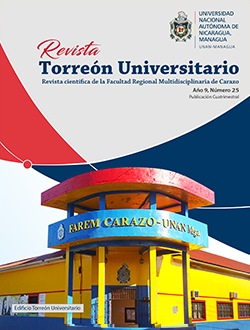Human hair to assess exposure to arsenic in users of contaminated water from La Fuente community in La Paz Centro, León.
DOI:
https://doi.org/10.5377/torreon.v9i25.9856Keywords:
hydroarsenicism, biomarker, bioaccumulation, thermalism, Momotombo volcanoAbstract
The presence of Arsenic in the surface and groundwater of Nicaragua is related to the geoenvironments present in the country. The study area is located NE of the Momotombo volcano, located in the volcanic arc in front of the Nicaraguan Depression, where the predominant geological material is rocks and sediments of the alluvial and volcanic Quaternary. The community of La Fuente is made up of 112 families (1300 inhabitants) that are mostly supplied with water by artisanal sources (90 dug wells and three drilled wells, one of them is communal). In a previous study, total arsenic in water was determined in a range of 2.0 to 103.0 µg/L, with the highest value being reported in a thermal spring; where 70% of the sites monitored (24 wells) reports values not suitable for human consumption (greater than or equal to 10 µg/L). The arsenic present in the water is absorbed by the tissues to be subsequently eliminated in the urine; but when the intake is greater than excretion it tends to be accumulated in hair and nails, as in urine and blood; these are excellent biomarkers to determine acute and chronic exposure to this metalloid. Considering the time of ingestion of water contaminated with arsenic by residents of La Fuente, it was decided to determine whether there is arsenic in the residents of La Fuente, using human hair as a biological indicator. A focus group was identified for this study considering the highest concentrations of arsenic present in water, as well as the longest intake time, resulting in a population group of 43 women and 9 men. Approximately 5 grams of hair was collected from each individual to be evaluated, totaling 52 hair samples. Arsenic concentrations detected in hair ranged from 0.014 to 0.925 µg·g-1; being these values less than 1.00 µg·g-1, standard established as a toxicity criterion by the Quebec Toxicological Center (CTQ). The highest concentrations of arsenic are associated with the oldest person (woman 90 years old) probably due to the longer exposure time; and the youngest (child 7 years), probably because this pollutant is transmitted from mother to children through the umbilical cord, the newborn presenting a concentration similar to her mother at birth. The community members were informed of their results as part of the social commitment to the population subject to the study.
Downloads
Downloads
Published
How to Cite
Issue
Section
License
The authors who publish in this journal agree to the following terms.
- The author or authors of the articles, essays or research grant the National Autonomous University of Nicaragua, Managua (UNAN-Managua) the editing rights (copyright) of the submitted work, therefore the University has the exclusive right to publish the article for the entire copyright period.
- These copyrights/authors authorize Torreón Universitario Magazine and the University to edit and disseminate/publish the article in said Magazine, including printed and electronic reproduction, storage, retrieval and any other type of publication, and sources of secondary information as services. of summaries and databases, they also empower it to protect the article against unauthorized use for dissemination by printed or electronic media (PDF, HTML, EPUB, XML or others).
License for use of content
The magazine uses the Creative Commons Attribution-NonCommercial-NoDerivs 4.0 International License.
Under this statement:

This journal is licensed under a Creative Commons Attribution-NonCommercial-NoDerivatives 4.0 International License. It can be copied, distributed and transmitted publicly as long as the author and source are cited (Revista Torreón Universitario), it should not be modified or used for any commercial purpose. The full license can be found at http://creativecommons.org/licenses/by-nc-nd/4.0/.



